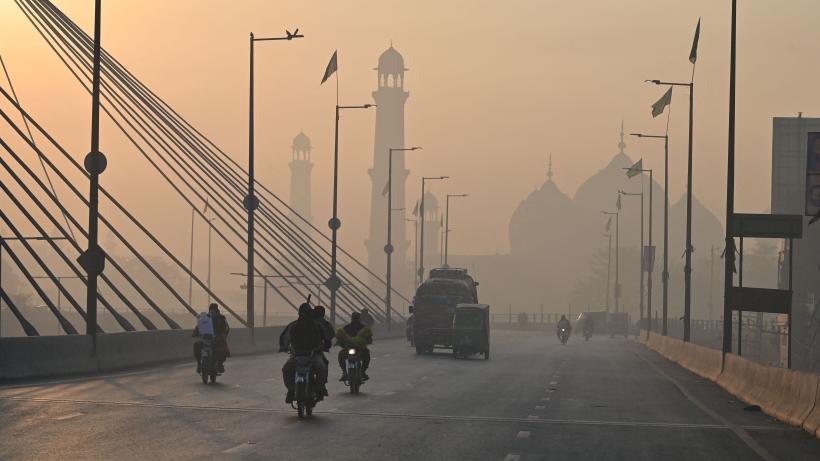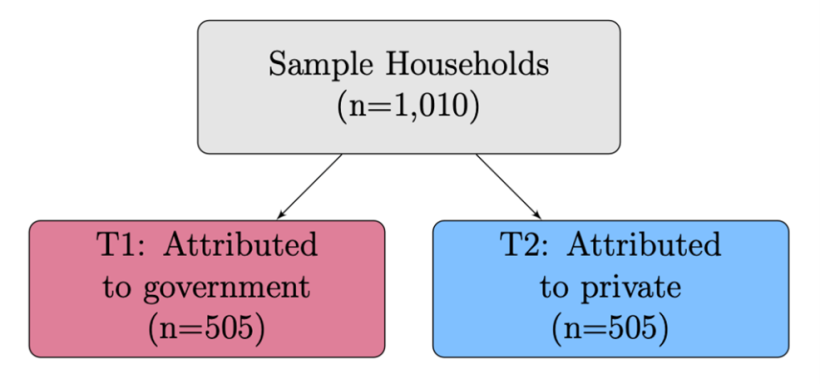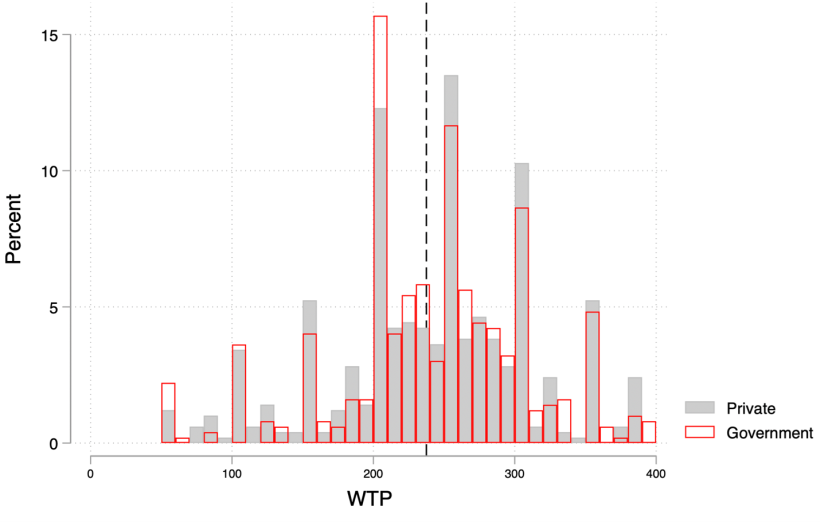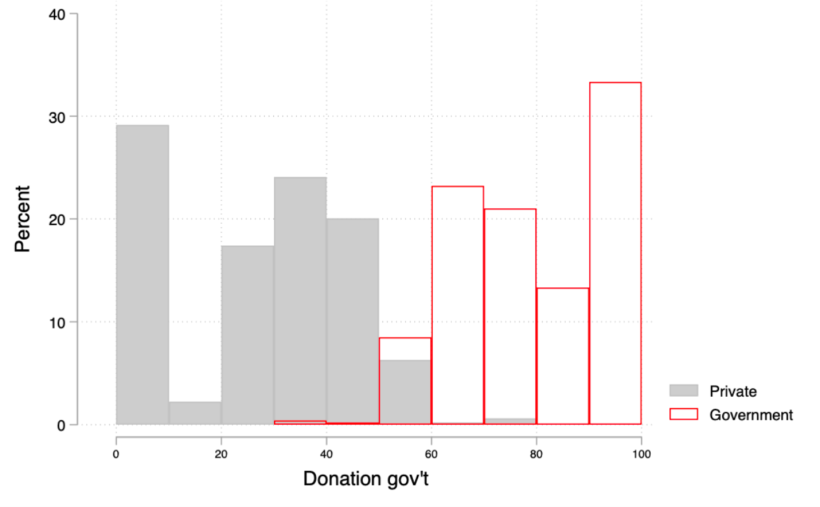
Public versus private: The impact of source on air quality information in Pakistan
The willingness of urban residents to pay for air pollution forecasts demonstrates a strong demand for such information. Research reveals that information source affects people’s beliefs on information quality and preferences but has little influence on their willingness to pay for it. The findings highlight significant opportunities for both government and private entities to contribute to the provision of air quality information in developing countries.
Our recent field experiment in Lahore, Pakistan, revealed that urban residents of developing countries exhibit a substantial willingness to pay for air pollution forecasts. Residents were willing to pay, on average, the monthly cost of 4G internet services for two months of pollution forecasts through SMS. Consuming pollution forecasts further increases demand for avoidance goods such as particulate filtering masks and improves the alignment of outdoor time with actual pollution levels. Thus, scaling air pollution information can yield large public benefits.
Governments in developing countries, however, struggle to consistently provide air quality readings. Often, a lack of resources and capacity inhibits their ability to maintain the infrastructure for gathering and disseminating information. Governments may also perversely withhold information to obscure the true extent of air quality deterioration. As a result, government air quality data remains patchy - monitors go offline unintentionally when concerned departments fail to pay data and electricity charges or intentionally when officials seek to mask readings.
To fill the data void created by governments, several private initiatives have sprung up, offering residents alternative sources of air quality information. In Lahore, the Pakistan Air Quality Initiative (PAQI) – a private citizens group – crowd-sources low-cost air pollution monitors across the city, reporting hourly readings on Twitter (now X) and a mobile app at no charge. While private sources such as the PAQI may improve access to air quality information, their efficacy depends on the perceived accuracy of their data and the trust residents place in these sources. Given competing sources, it remains unclear whether the quality of the service and/or the residents' beliefs about the reliability of these sources drive the demand for information services.
Differentiating between private and public sources of pollution information
Suppose a person wants air pollution forecasts and must choose between a public source and a private source to receive them. Even if the sources’ forecast quality is identical, she or he may exhibit a lower willingness to pay for forecasts that they believe is of lower quality. Figure 1 reveals that working-class residents of Lahore who typically do not consume any air pollution information are indifferent between private and public sources of pollution information, as measured through a donation game. Introducing residents to either type of source could potentially alter their perceptions about these sources which in turn could influence the demand for air quality information.
Figure 1: Donation to government versus private sources of air pollution

Note: This figure shows the result from a donation game in our baseline survey, in which we asked respondents to split PKR 100 between government (EPD) and private (PAQI) sources. Each bar represents the percentage of respondents who chose to donate a certain percentage of the PKR 100 to EPD compared to PAQI. The highest bar indicates that the majority of respondents chose to allocate 50% of the funds to EPD, suggesting a relatively weak preference between sources.
Understanding whether the source of air quality information matters to the citizens
To study citizens’ beliefs about and demand for air quality information, we ask the following broad questions: 1) Are citizens willing to pay for air quality information regardless of its source? 2) Does willingness to pay for air quality information vary by source? 3) Does the source affect beliefs about service quality and the state of air pollution? 4) Does exposure change preferences for sources?
To answer these questions, we conducted a randomised controlled trial with roughly 1,000 residents of a lower-middle-income neighbourhood in Lahore, Pakistan. We first developed a forecast model of day-ahead air pollution using data from both government and private sources. We then provided daily forecasts through SMS (text messages) to all our respondents for four months. We randomised the disclosed source of information. In one treatment arm, we informed respondents that we constructed the forecasts that includes inputs from a government source (Environmental Protection Department Punjab [EPD]), while in the other treatment arm, we informed respondents that we constructed the forecasts that includes input from a private source (PAQI). Thus, we provided respondents with identical forecasts while varying the attributable information source. Figure 2 depicts the experimental arms.
We measured four primary outcomes: 1) willingness to pay for air pollution forecasts; 2) beliefs about the next day’s air pollution level; 3) beliefs about the accuracy of our forecasts; and 4) willingness to donate to government and private agencies. To elicit truthful responses, we incentivised the four outcomes.
Figure 2: Treatment arms

Note: The figure illustrates the experimental design of the study showing how households were divided into two experimental treatment groups – T1: Attributed to government (n=505) - This group represents half of the sample households that were provided with daily air pollution forecasts and were informed that these forecasts were constructed using data from a government source. T2: The other half of the sample households were also provided with daily air pollution forecasts, but they were told that the forecasts were based on data from a private source.
Results
1. Residents value air pollution information – this corroborates what we knew before. We find that our respondents (residents of a working-class neighbourhood of Lahore) were willing to pay on average PKR 238 to continue receiving air pollution forecasts for another two months (Figure 3). This amount roughly translates into the monthly cost of prepaid mobile and data services. Thus, scaling the service across the city home to nearly 14 million residents, promises substantial public benefits.
Figure 3: Willingness to pay (WTP) for air pollution forecasts

Note: This figure shows the willingness to pay (WTP) in Pakistani Rupees (PKR) for air pollution forecasts within each treatment arm. The grey bars represent the WTP distribution for respondents who receive forecasts attributed to the PAQI (private source). The red bars represent the WTP distribution for respondents who receive forecasts attributed to the EPD (government source). The dashed line marks the average willingness to pay (PKR 238), pooling both arms.
2. The source of information does not affect their willingness to pay. Our findings show no significant difference in willingness to pay for forecasts whether they are from government or private sources. Respondents valued the forecast service equally irrespective of the source.
3. While the source of information doesn’t significantly alter respondents’ perceptions of air pollution levels, it slightly shifts beliefs about forecast accuracy. Respondents receiving forecasts attributed to the government expect a 12% higher error rate in the forecast relative to the private arm. Thus, respondents in the government arm perceive government-sourced forecasts as lower quality, yet their willingness to pay remains on par with those receiving forecasts from private sources.
4. Recipients prefer the source assigned to them during the study. In a baseline survey conducted before we started the forecast service, most respondents equally split an endowment of PKR 100 between the EPD (government source) and the PAQI (private source). However, after receiving the forecasts for two months, the respondents split the endowment roughly 75:25 in favour of the source that was initially assigned to them (Figure 4). Thus, illustrating the relative malleability of citizens’ preferences for air quality sources.
Figure 4: Donation to government versus private source of air quality information

Note: This figure shows how respondents within each treatment arm allocate a PKR 100 endowment to the EPD. The grey bars represent respondents who receive forecasts attributed to the PAQI (private source). The red bars represent respondents who receive forecasts attributed to the EPD (government source).
Policy takeaways
Our work demonstrates how urban residents of developing countries value air pollution information, exhibiting considerable demand for pollution forecasts even when this information isn’t broadly available. Investing in pollution monitoring and forecasting would considerably enhance public welfare with the benefits within cities potentially dwarfing the costs. We also find that the source of information doesn’t change citizens’ demand for it. Those who receive government data value it as much as those who receive private data. Policymakers can leverage private sources to scale up the provision of air quality information, complementing the government’s own data. Our findings also point to opportunities for private firms to sell air quality information in developing countries’ markets.

